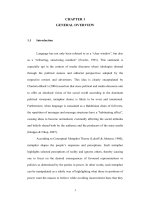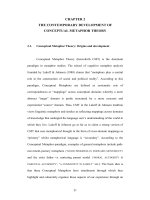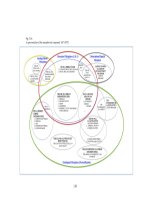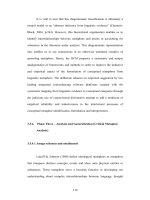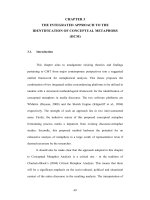Study of the chemical composition and am
Bạn đang xem bản rút gọn của tài liệu. Xem và tải ngay bản đầy đủ của tài liệu tại đây (272.31 KB, 6 trang )
International Journal of Advanced Engineering Research and
Science (IJAERS)
Peer-Reviewed Journal
ISSN: 2349-6495(P) | 2456-1908(O)
Vol-8, Issue-8; Aug, 2021
Journal Home Page Available: />Article DOI: />
Study of the Chemical Composition and Amtimicrobial
Action of Dillenica Indica Peel, Fruit and Leaves Extracts
Gabriela Celeguim1, Wanderson de Oliveira dos Santos2, Ana Claudia Granato3, Mônica
Hitomi Okura4
1,3,4
Universidade Federal do Triângulo Mineiro, Programa de Mestrado Profissional em Inovaỗóo Tecnolúgica.
Empresa OuroFino Agrociờncias, Uberaba-MG.
2
Received: 07 Jul 2021,
Received in revised form: 03 Aug 2021,
Accepted: 10 Aug 2021,
Available online: 17 Aug 2021
©2021 The Author(s). Published by AI
Publication. This is an open access article
under the CC BY license
( />Keywords— medicinal plants, antimicrobial
extracts, Dillenia indica, bioactivity.
I.
Abstract— The use of medicinal plants has grown over the years, this is
due to the popular culture that already exists and to the increase in
people's knowledge about the benefits of these plants. Dillenia indica
popularly known as elephant apple or april flower is considered a
medicinal plant that, according to studies, has antidepressant, antileukemic,
anti-inflammatory,
antioxidant,
anti-diabetic,
antihyperlipidemic, antimicrobial, cytotoxic and anxiolytic properties. This
factor aroused interest in obtaining extracts of this to evaluate the
antimicrobial action of these extracts. To obtain the extracts, separate
samples of the leaves, bark and seeds were kept in contact with ethyl
acetate for 3 days with daily agitation. After this period, the extract was
filtered and dried by rotary evaporation. The analysis of the chemical
composition of the extracts was performed by a Gas Chromatography
coupled with Mass Spectrometry. The antimicrobial effect of the extracts
was verified by the minimum inhibitory concentration (MIC) and minimum
bactericidal concentration (MBC). The values of MBC and MIC of the
extracts of leaves, bark and seeds against the microorganisms in question
were 0.1% v/v. Employing chromatography it was possible to identify
several organic acids in the three extracts of D. indica. These acids are
probably the compounds responsible for the antibacterial activity shown by
the studied extracts.
INTRODUCTION
According to Maciel, Pinto and Veiga (2002), the
popular culture of using medicinal plants and the
efficiency of their use, that is, the beneficial effects that
their use provides, collaborate in a significant way for the
practice of consumption of medicines plants. As a result,
this popular culture arouses the curiosity and interest of
researchers in developing this natural resource for
medicinal purposes. According to Jawla et al. (2009),
medicinal plants have provided many clues to fighting
diseases since the emergence of civilization.
www.ijaers.com
India is one of the 12 biodiversity centers in the world,
with more than 45.000 different plant species (Jawla et al.,
2009). There are many species of plants that have been
used by tribal communities and in various regions of India,
but their pharmacological and phyto-pharmacological
importance are still unknown as these plants are rarely
available. Among these plants there are several belonging
to the family Dilleniaceae, which are not very well known,
but have considerable medicinal value (Gandhi & Mehta,
2013). According to Bhagyasri et al. (2017), several
studies report the potential of D. indica (Figure 1) to assist
Page | 191
Daniel Szente Fonseca et al.
International Journal of Advanced Engineering Research and Science, 8(8)-2021
in wound healing, diabetes, bone fracture, cuts, burns and
abdominal pain.
aeruginosa, Salmonella paratyphi, Salmonella typhi,
Shigella boydii, Shigella dysenteriae, Vibrio mimicus and
Vibrio mimicus parahemolyticus). Haque et al. (2008)
commented that the ethyl acetate leaf extract had
antifungal properties against Candida albicans,
Aspergillus niger and Saccharomyces cerevisiae.
Considering the above, the present study aimed to
evaluate the chemical composition and antimicrobial
activity of the extracts of the D. indica.
II.
Fig.1: Dillenica indica: A- fruit, B- cross section of the
fruit, C- fruit pulp.
D. indica is known for its antidepressant, antileukemic, anti-inflammatory, antioxidant, anti-diabetic,
anti-hyperlipidemic,
anti-microbial,
cytotoxic
and
anxiolytic properties (Kumar, Kumar and Prakash, 2011).
The genus Dillenia has 60 species, but only the plants D.
indica and D. pentagyna are considered to have significant
medicinal value. The leaf, bark and fruit of these plants are
used as traditional medicine and have therapeutic effects
(Gandhi & Mehta, 2013). The plant is a small to medium
sized tree growing up to 15 m in height. Its leaves are 15 to
36 centimeters long, with a visibly wavy surface with
printed veins (Bhagyasri et al., 2017) and the flowers are
large, 15 to 20 centimeters in diameter with five white
petals and numerous yellow stamens. The fruits are 10 to
15 cm in diameter, with undefined and persistent sepals,
fleshy and slightly swollen. The seed contains 5 or more
carpels, soaked in compressed, glutinous pulp, with hairy
margins. Fruit production occurs from July to August and
ripens in November and December. The flowers occur in
May and June (Gandhi & Mehta, 2013).
According to Kumar, Kumar and Prakash (2011), the
methanolic extract of fruits of D. indica L. display
significant antileukemic activity in human leukemic cell
lines. This finding led to the chromatographic fractionation
of the methanolic extract and from this fractionation, the
ethyl acetate fraction displayed the greatest anti-leukemic
activity. Bhagyasri et al. (2017) comment that the main
compound was betulinic acid, and that betulinic acid could
explain the anti-leukemic activity of the methanolic extract
and the ethyl acetate fraction.
Apu et al. (2010)
reported the antimicrobial properties of D. indica ethyl
acetate leaf extract against Gram-positive bacteria
(Bacillus cereus, Bacillus megaterium, Bacillus subtilis,
Staphylococcus aureus and Scarina lutea) and Gramnegative bacteria (Escherichia coli, Pseudomonas
www.ijaers.com
METHOD
Sampling: The fruits of the D. indica plant were collected
in the months of April, May and October of 2019 in Guará,
São Paulo state - Brazil, located at latitude 20º25'42 "south
and at longitude 47º49'27" west, where there are a
considerable number of trees of this species.
Obtaining the extracts: For the extraction of D. indica,
ethyl acetate solvent and three parts of the plant were used:
leaves, seeds, and fruit peel. The fruits were separated and
cut into small pieces and immediately afterwards were
placed in flasks together with each of the solvents
separately and sealed so that the volatilization of the
solvents would not occur. The leaves were placed in
separate flasks with for each of the solvents and sealed.
The three parts of the plants were kept immersed in the
solvent separately for seven days. After that, the acetate
extract was filtered and concentrated. This extraction
process was carried out in triplicate, and the extracts were
stored in amber sealed amber flasks, under refrigeration
until analysis.
Microorganisms tested: The reference strains used were
E. coli (ATCC 35218), S. aureus (ATCC 29213) and B.
cereus (ATCC 11778). The bacterial strain was reactivated
using Müeller Hinton agar and incubated at 37°C for 24
hours. For this study, bacterial suspensions prepared using
the direct suspension method were used as inoculum, in
which four colonies were suspended in sterile saline
solution and adjusted to the standard 0.5 of the McFarland
scale in a spectrophotometer at 625 nm. This procedure
ensures that each milliliter of the inoculum has
approximately 1.5x108 Colony Forming Units (CFU)
((NCCLS, 2003a). For the extract, saline solution was used
as a positive control and chlorhexidine was used as
negative control.
Minimum Inhibitory Concentration (MIC): The
determination of the minimum inhibitory concentration
(MIC) of the extracts obtained in this study was performed
in microdilution plates with 96 wells arranged in 12
columns and 8 rows. First, an initial standard solution of
the extract with a concentration of 8% was prepared using
Page | 192
Daniel Szente Fonseca et al.
International Journal of Advanced Engineering Research and Science, 8(8)-2021
0.4 ml of the extract, 0.05 ml of Tween 80 and 4.2 ml of
sterile distilled water. In the microdilution plate, 6
dilutions were tested for each microorganism. In each of
the wells of the plate, 100 µL of the Müeller Hinton broth
were added. Then 100 µL of the initial standard solution of
each extract was added to the second line (B) and the
subsequent concentrations were obtained through serial
dilution, resulting in concentrations of 4% to 0.1%. In the
end, 100 µL of the contents were dispensed in the wells of
the last line, so that the volume would be equal to the
others. The wells of the 1st row were used as growth
control, the extract was not added and the wells of the 8th
row as negative control (Chlorhexidine 2%). At the end,
10 µL of the bacterial suspension were added to all wells
and the plates with the bacteria were incubated at 37°C for
48 hours. MIC was the lowest concentration that
completely inhibited growth, that is, in which no turbidity
was observed in the medium. The tests were performed in
triplicate (Cavalcanti, Almeida and Padilha, 2011,
NCCLS, 2003b)
Minimum bactericidal concentration (MBC): To
determine the antibacterial activity of the D. indica extract,
the MBC was determined. The analysis consists of adding
extract concentrations equal to or greater than that of the
MIC to tubes containing BHI broth. Subsequently, bacteria
were inoculated into the tubes, which are intended to
analyze the antibacterial effect. For control, tubes were
produced only with BHI and extract. The tubes were
incubated for 16 hours, at a temperature of 37º under
agitation. After that, they passed through a centrifuge
where the supernatant was discarded, and the bacterial
cells were resuspended in BHI broth and inoculated in the
plates containing the appropriate culture medium. The
plates were incubated at the appropriate temperature and
time for the growth of each bacterium, after which the
plates were analyzed visually (Santurio et al., 2007).
Gas chromatography coupled to Mass Spectrometry
(GC-MS): GC-MS analyzes were carried out in
collaboration with Ourofino AgroCiência in Uberaba-MGBrazil. For GC-MS analysis, samples were prepared by
weighing 1g of extract in a 10 mL volumetric flask. Then,
5 ml of HPLC grade acetone were added and the system
was ultrasound for 10 minutes. The volume of the
volumetric flask was measured, the solution homogenized
and filtered through a 0.45 μm RC filter. The analyzes by
GC-MS were performed on a High-Resolution Gas
Chromatograph, Shimadzu, model 2010 with Mass
Spectrometry Detector. Column: Agilent DB-5MS (30 m x
0.25 mm - 0.25 μm). The operating conditions were:
Injector temperature: 220° C, Injection Mode: Splitless,
Sampling time: 2 minutes, Flow control mode: Linear
speed (45.0 cm.seg-1), Pressure: 15.7 psi, Total flow: 19.4
www.ijaers.com
mL min-1, Column flow: 1.49 mL min-1, Column
temperature: Gradient mode, as shown in the table 1:
Table 1 - Data used in the temperature gradient for the
analysis of GC-MS.
Ratio (°C/min)
Final
Temperature (°C)
Residence time
(min)
-
80
2
40
140
-
10
280
-
The Parameters of the Mass Spectrometry Detector were:
Ion source temperature: 200° C, Interface temperature:
280° C, Solvent cutting time: 3 minutes, Detector voltage:
Relating to the result of the Tuning, Initial detection time:
3.0 minutes, Final detection time: 17.0 minutes,
Acquisition mode: SCAN, Acquisition time: 0.25 seconds,
SCAN mass / charge ratio (m / z): 40 to 600, Injection
volume: 1 μl.
III.
RESULTS AND DISCUSSION
MIC and MBC
The MIC values of D. indica extracts from leaves,
bark and seeds against E. coli, S. aureus and B. cereus
were 0.1% v/v for the three analyzed extracts. This result
was more efficient than the work of Zauli et al. (2004)
which analyzed MIC and MBC for D. indica against E.
coli (ATCC 8739), S. aureus (ATCC 6538), S.
typhimurium (ATCC 14028), P. aeruginosa (ATCC
25619) Streptococcus mutans (ATCC 25175) S. salivarius
(CDC 262) and obtained in the MIC 95.8 mg/mL for E.
coli and S. typhimurium and 47.9 mg/mL for S. aureus, P.
aeruginosa, S. mutans and S. salivarius and in the MBC
concentration of 71.85 mg/mL for S. aureus, P.
aeruginosa, S. mutans and S. salivarius, and greater than
95.8 mg/mL for E. coli and S. typhimurium.
Apu et al. (2010) investigated the leaves of the methanolic
crude extract of D. indica Linn. (Dilleniaceae) for the
evaluation of antimicrobial activities. Antimicrobial
activity was determined using the disk diffusion method.
The mean zone of inhibition ranged from 6 to 8 mm at a
concentration of 400 µg/disc. Alam, Chowdhury and
Mazumder (2011), tested the methanolic extract of the
bark of D. indica against four Gram positive and seven
Gram negative bacteria and remarkable activities against
all the tested bacteria were observed. The lowest minimum
inhibitory concentration (MIC) value was observed in
Staphylococcus aureus and was 0.312 %. Reddy et al.
(2009), commented that the hexane extract from the seed
powder of D. indica was evaluated for antimicrobial and
antioxidant activities and exhibited a broad spectrum of
Page | 193
Daniel Szente Fonseca et al.
International Journal of Advanced Engineering Research and Science, 8(8)-2021
antimicrobial activity. MIC values for different bacterial
and fungal strains ranged in concentration from 1.0 to 2.0
mg/ml.
GC-MS of bark extracts
After the separation by gas chromatography of the extract
of the D. indica bark, 9 peaks were obtained, as given in
Figure 2, which were analyzed by Mass Spectrometry for
their structural determination.
Fig.4: Chromatogram of separation of the extract of the
leaves of D. indica by GC-MS.
Table 2 summarizes the chemical compounds found in the
studied extracts and figure 5 summarizes the chemical
structures of the compounds found in the studied extracts.
Table 2. Compounds present in the studied extracts of D.
indica.
Bark Extract
•
Fig.2: Chromatogram of separation of the D. indica bark
extract by GC-MS.
GC-MS of pulp extract (seed)
After the gas chromatographic separation of the pulp
extract of the D. indica seed, 9 peaks were also obtained
(Figure 3), which were analyzed by Mass Spectrometry for
their structural determination.
Fig.3: Chromatogram of separation of the D. indica seed
extract by GC-MS.
•
www.ijaers.com
Malic
acid
•
Propanoi
c acid
•
1(ptoluidine)
-1-deoxybeta-diodopyra
nose
•
Tridecan
e
•
1dodecan
ol
•
•
Leave extract
•
Vanilic
acid
4hidroxy
-4methylpentan
one
•
3methylheptadec
ane
Isobuty
l
acetate
•
dodeca
nol
•
Acrylic
acid
•
Hexadec
ane
•
Palmitic
acid
•
Eicosane
•
•
2monopal
mitine
Palmitic
acid
•
Linoleic
acid
•
Linoleic
acid
•
Estearic
acid
•
(7Z)tetradece
nal
•
Estearic
acid
1) GC-MS of leave extract
After gas chromatographic separation of the D. indica leaf
extract, 4 peaks were also obtained, as shown in Figure 4,
which were analyzed by Mass Spectrometry for their
structural determination.
5hidroxym
ethylfurf
ural
Pulp extract
(seed)
Page | 194
Daniel Szente Fonseca et al.
International Journal of Advanced Engineering Research and Science, 8(8)-2021
known as fatty acids15. Thus, probably, the organic acids
present in the studied extracts are the compounds
responsible for the antibacterial activity presented by the
studied extracts.
BARK EXTRACT
OH
O
HO
O
O
O
5-hidroxymethylfurfural
O
O
propanoic acid
OH OH
malic acid
NH
OH
O
O
HO
palmitic acid
OH
OH
1(p-toluidine)-1-deoxy-beta-d-iodopyranose
OH
O
HO
OH
O
O
2-monopalmitine
O
(7Z)-tetradecenal
OH
O
OH
linoleic acid
estearic acid
PULP EXTRACT (SEED)
HO
HO
tridecane
O
1-dodecanol
O
OH
vanilic acid
3-methyl-heptadecane
O
hexadecane
As stated by Ricke (2003), organic acids are able
to decouple the cytoplasmic membrane. Organic acids are
believed to interfere with the structure of the cytoplasmic
membrane and membrane proteins, so that electron
transport is decoupled, and subsequent ATP production is
reduced. Another hypothesis is that organic acids serve as
decouplers that generally dissipate pH and electrical
gradients across cell membranes.
palmitic acid
OH
eicosane
O
OH
O
OH
estearic acid
linoleic acid
Less direct antibacterial activities have also been
attributed
to organic acids and include interference with
O
nutrient transport, damage to the cytoplasmic membrane
O
resulting in leakage, disruption of the permeability of the
Isobytyl acetateouter membrane and influence of macromolecular
synthesis (Ricke, 2003).
LEAF EXTRACT
O
According to Ricke (2003) the potential bacterial
targets of biocidal compounds include the cell wall and the
cytoplasmic membrane. Although the antibacterial
mechanisms for organic acids are not fully understood,
there are some proposals for the mode of action of these
compounds. Given the weak acidic nature of most of these
compounds, pH is considered a determinant of
effectiveness, because it affects the concentration of
undissolved acid formed. Non-dissociated forms of
organic acids can penetrate the lipid membrane of the
bacterial cell and, once at the neutral pH of the cell
cytoplasm, dissociate into anions and protons. The
generation of both species causes problems for the bacteria
that must maintain a cytoplasm with a pH close to 7 to
support the functional macromolecules. Excess proton
exports require consumption of cellular adenosine
triphosphate (ATP) and can result in depletion of cellular
energy.
OH
4-hidroxy-4-methyl-2-pentanone
O
OH
Dodecanol
OH
Acrylic acid
Fig.5: Chemical structure of the compounds presents in
the extract of the bark of D. indica.
Analyzing Table 2 and Figure 5, it is possible to
observe the presence of several organic acids in the three
extracts of D. indica. The organic acids have been used as
food additives and preservatives to prevent food spoilage
and prolong the shelf life of perishable foods. As a group,
these compounds mainly include straight chain saturated
monocarboxylic acids and their derivatives (unsaturated,
hydroxyl, phenolic and multicarboxylic versions) and are
www.ijaers.com
IV.
CONCLUSIONS
Through this study it can be concluded that the extracts of
D. indica (leaves, fruits and seeds) showed antimicrobial
activity, with antimicrobial efficiency of the three extracts
against all tested microorganisms. From the chemical
evaluation made with the extracts, there are many organic
acids in their constitution and these compounds are
possibly responsible for the antimicrobial activity observed
in this study. The studied extracts have promising
characteristics for use as natural antimicrobial species in
both the food, pharmaceutical and cosmetic industries in
order to replace synthetic antimicrobials.
Page | 195
Daniel Szente Fonseca et al.
International Journal of Advanced Engineering Research and Science, 8(8)-2021
REFERENCES
[1] Alam, M.B., Chowdhury, N.S., Mazumder, M.E.H. (2011).
Antimicrobial and toxicity study of different fractions of
dillenia indica linn. bark extract. International Journal of
Pharmaceutical Science Reseearch, 2(4), 860-866. doi
10.13040/IJPSR.0975-8232.2(4).860-66
[2] Apu, A., Muhit, M., Tareq. S., Pathan, A.H., Jamaluddin,
A.T.M., Ahmed, M. (2010). Antimicrobial activity and
brine shrimp lethality bioassay of the leaves extract of
Dillenia indica Linn. Journal of Young Pharmacists,
2(1),50–53. doi: 10.4103/0975-1483.62213
[3]
Bhagyasri, Y., Goud, D.S., Suvarna, M., Subramanian,
N.S. (2017). A pharmacological review on elephant apple.
World Journal of Pharmaceutical Science, 6(12),18091816.
[4] Cavalcanti, Y.W., Almeida, L.F.D., Padilha, W.W.N.
(2011). Atividade antifúngica de três Óleos Essenciais
sobre cepas de Candida. Revista Odontológica do Brasil
Central, 20(52),77-82.
[5] Gandhi, D., Mehta, P. (2013). Dillenia indica linn. and
Dillenia pentagyna roxb.: pharmacognostic, phytochemical
and therapeutic aspects. Journal of Applied Pharmaceutical
Science, 3, 134-142. doi: 10.7324/JAPS.2013.31124
[12] Reddy, K.H., Reddy, K.B.N., Sharma, P.V.G.K., Reddy,
O.V.S. (2009). In vitro studies on antimicrobial and
antioxidant activities of Dillenia indica seed extract.
Journal of Pure Applied Microbiology, 3(2), 769-776.
[13] Ricke, S.C. (2003). Perspectives on the Use of Organic
Acids and Short Chain Fatty Acids as Antimicrobials.
Poultry
Science
Jorunal,
82:632–639.
doi:
10.1093/ps/82.4.632
[14] Santurio, J.M., Santurio, D.F., Pozatti, P., Moraes, C.,
Frachin, P.R., Alves, S.H. (2007). Atividade antimicrobiana
dos óleos essenciais de orégano, tomilho, e canela frente a
sorovares de Salmonella entérica de origem avícola.
Ciência Rural, 37(3), 803-808. doi: 10.1590/S010384782007000300031
[15] Zauli, R.C., Pereira, M.A., Cardoso, L.G.V., Silva,
J.M.S.F., Carvalho, J.C.T., Fioorini, J.E. (2004). Atividade
antimicrobiana e determinaỗóo da concentraỗóo inibitúria
mớnima e concentraỗóo bactericida mớnima de Dillenia
indica L. (Flor de abril). III SEMIC (Seminỏrio de
Iniciaỗóo Cientớfica da Unifenas.
[6] Haque, E., Islam, N., Hossain, M., Mohamad, A.U.,
Karim, M.D.F.
(2008). Antimicrobial and cytotoxic
activities of Dillenia pentagyna. Dhaka University Journal
of Pharmaceutical Sciences, 7(1), 103-105.
[7] Jawla, S., Gupta, A., Singla, R., Gupta, V. (2009). General
awareness and relative popularity of allopathic, ayurvedic
and homeopathic systems. Journal of Chemical and
Pharmaceutical Research, 1(1),105-112.
[8] Kumar, S., Kumar, V., Prakash, O. (2011). Antidiabetic,
hypolipidemic and histopathological analysis of Dillenia
indica (L.) leaves extract on alloxan induced diabetic rats.
Asian Pacific Journal of Tropical Medicine, 4(5), 347-52.
doi: 10.1016/S1995-7645(11)60101-6
[9] Maciel, M.A.M., Pinto, A.C., Veiga, V.F. (2002). Plantas
medicinais: a necessidade de estudos multidisciplinares.
Química Nova, 25(3), 429-438. doi: 10.1590/S010040422002000300016
[10] National Committee for Clinical Laboratory Standards
(NCCLS). Padronizaỗóo dos Testes de Sensibilidade a
Antimicrobianos por Disco-difusóo. Norma M2-A8, 8 ed.
v. 23, n. 1. 2003a.
[11] National Committee for Clinical Laboratory Standards
(NCCLS). Metodologia dos testes de sensibilidade a
agentes antimicrobianos por diluiỗóo para bactộria de
crescimento aerúbico. Norma M7-A6, 6 ed. v. 23, n. 2.
2003b.
www.ijaers.com
Page | 196



